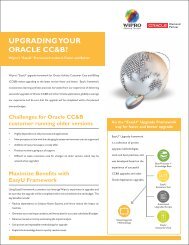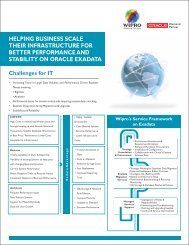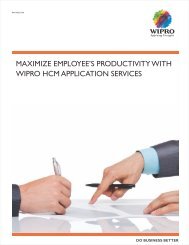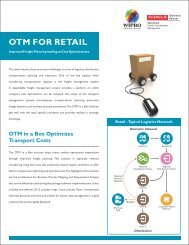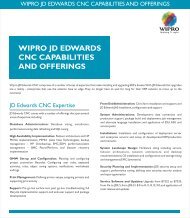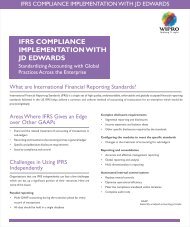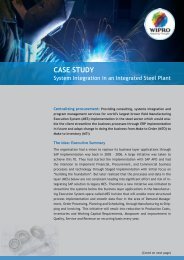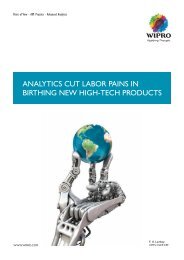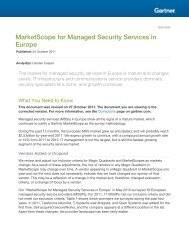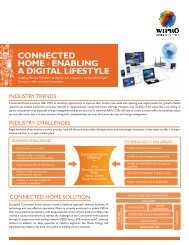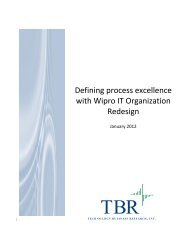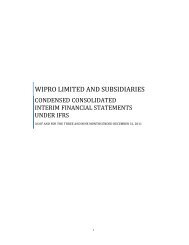Best Practices: Thames Water Adopts BPMS Solution to Streamline ...
Best Practices: Thames Water Adopts BPMS Solution to Streamline ...
Best Practices: Thames Water Adopts BPMS Solution to Streamline ...
You also want an ePaper? Increase the reach of your titles
YUMPU automatically turns print PDFs into web optimized ePapers that Google loves.
Global Headquarters: 5 Speen Street Framingham, MA 01701 USA P.508.935.4400 F.508.988.7881 www.idc-ei.com<br />
<strong>Best</strong> <strong>Practices</strong>: <strong>Thames</strong> <strong>Water</strong> <strong>Adopts</strong><br />
<strong>BPMS</strong> <strong>Solution</strong> <strong>to</strong> <strong>Streamline</strong> Its Cus<strong>to</strong>mer<br />
Services, with Wipro as Systems<br />
Integra<strong>to</strong>r<br />
IDC Energy Insights: European Utility IT Strategies<br />
BEST PRACTICES #EIOS05T<br />
Roberta Bigliani Daniella Muallem<br />
IDC ENERGY INSIGHTS OPINION<br />
This IDC Energy Insights report details <strong>Thames</strong> <strong>Water</strong>'s journey <strong>to</strong><br />
implement an advanced business process management system in its<br />
Cus<strong>to</strong>mer Services business unit, for eight months from 2010–2011.<br />
This approach enabled <strong>Thames</strong> <strong>Water</strong> <strong>to</strong> realize significant operational<br />
and business benefits in a short time despite financial constraints.<br />
● The ability <strong>to</strong> implement changes rapidly was critical <strong>to</strong> achieving<br />
satisfac<strong>to</strong>ry benefits. <strong>Thames</strong> <strong>Water</strong> decided <strong>to</strong> deploy a Business<br />
Process Management Suite (<strong>BPMS</strong>), working with long-term<br />
partner Wipro as the systems integra<strong>to</strong>r. The program was<br />
implemented in four stages (sprints) of 7–8 weeks, with new<br />
benefits realized at the end of each sprint.<br />
● By applying the <strong>BPMS</strong> <strong>to</strong> a range of business processes with<br />
impact on cus<strong>to</strong>mer satisfaction, the company succeeded in<br />
reducing contact volume and repeat rates <strong>to</strong> realize opex benefits.<br />
Qualitative benefits were also realized, including improvements in<br />
both employee and cus<strong>to</strong>mer satisfaction. Considerable savings in<br />
people hours (over 47,000) were achieved as a result of improved<br />
transaction handling time, au<strong>to</strong>mation of manual activities, and<br />
improvements in how data is presented <strong>to</strong> agents.<br />
● Even if the implementation of a strategic solution might represent<br />
the long-term choice for utilities, alternative cost-effective<br />
solutions with faster turnaround times are likely <strong>to</strong> become more<br />
appealing as increasing regula<strong>to</strong>ry demands and costs put pressure<br />
on utility spending.<br />
August 2011, IDC Energy Insights #EIOS05T<br />
IDC Energy Insights: European Utility IT Strategies: <strong>Best</strong> <strong>Practices</strong>
TABLE OF CONTENTS<br />
In This Study 1<br />
IDC Energy Insights Case Studies Series ................................................................................................ 1<br />
Situation Overview 1<br />
Company Overview .................................................................................................................................. 1<br />
Business Needs........................................................................................................................................ 2<br />
Management Challenges.......................................................................................................................... 2<br />
The <strong>Best</strong> <strong>Practices</strong> 3<br />
Background and Objectives...................................................................................................................... 3<br />
<strong>Solution</strong> Description.................................................................................................................................. 4<br />
Business Value......................................................................................................................................... 11<br />
Lessons Learned ...................................................................................................................................... 12<br />
Future Outlook 13<br />
Next Steps ................................................................................................................................................ 13<br />
Essential Guidance 13<br />
Project Impact Assessment ...................................................................................................................... 13<br />
Actions <strong>to</strong> Consider................................................................................................................................... 14<br />
Learn More 15<br />
References ............................................................................................................................................... 15<br />
Related Research..................................................................................................................................... 15<br />
#EIOS05T ©2011 IDC Energy Insights<br />
P
LIST OF FIGURES<br />
1 High-Level Architecture of the IT <strong>Solution</strong>.................................................................................... 5<br />
2 Example of a Business Process Map........................................................................................... 9<br />
3 Schedule for Sprint Deliveries from BPR and <strong>BPMS</strong> IT Delivery Work Streams.......................... 10<br />
4 IT and Business Change Delivery Timescales for Various Sprint Releases ................................ 10<br />
5 <strong>Thames</strong> <strong>Water</strong> Project Impact Assessment ................................................................................. 14<br />
©2011 IDC Energy Insights #EIOS05T<br />
P
IN THIS STUDY<br />
This study describes the IT approach taken by <strong>Thames</strong> <strong>Water</strong> <strong>to</strong><br />
improve the efficiency of its Cus<strong>to</strong>mer Services business unit in the<br />
light of reduced IT budgets following the economic crisis of<br />
2008–2009. This study reviews the program implemented <strong>to</strong> review<br />
and reengineer selected business processes and implement a Business<br />
Process Management Suite (<strong>BPMS</strong>), identifying the company's<br />
objectives, the selection process for identifying the right solution, the<br />
business value of the project, and next steps for the company.<br />
IDC Energy Insights Case Studies Series<br />
The IDC Energy Insights Case Studies Series provides utilities with<br />
fact-based, comparable, consistent, and independent views of<br />
interesting projects implemented across geographies. The focus is on<br />
IT solutions or, more broadly, on energy technology assessments<br />
contributing <strong>to</strong> sustainability. Collaborating with the utility company<br />
and IT vendor personnel directly involved in the projects, IDC Energy<br />
Insights is able <strong>to</strong> gather all the relevant information, analyze the<br />
approach, and assess the solutions aimed at meeting organizations'<br />
goals. Case studies are assessed on four criteria, which IDC Energy<br />
Insights believes are critical <strong>to</strong> generate additional value: contribution<br />
<strong>to</strong> operational effectiveness, degree of technological innovation,<br />
transformational impact on the company's businesses, and more<br />
broadly, on the utilities industry value chain.<br />
Why This Case Study?<br />
This case study was selected as a demonstration of a <strong>Best</strong> <strong>Practices</strong><br />
approach in the Cus<strong>to</strong>mer Services unit of one of the major U.K. water<br />
utilities, highlighting the value that can be brought in by <strong>BPMS</strong><br />
implementation. Though seen as an interim solution until the<br />
implementation of integrated Billing/CRM software is undertaken, this<br />
case study demonstrates the fast returns that can be made <strong>to</strong> improve<br />
operations while waiting for long-term plans <strong>to</strong> be implemented.<br />
SITUATION OVERVIEW<br />
Company O verview<br />
<strong>Thames</strong> <strong>Water</strong> is the U.K.'s largest water and wastewater services<br />
company, serving 13.8 million cus<strong>to</strong>mers across London and the<br />
<strong>Thames</strong> Valley. <strong>Thames</strong> <strong>Water</strong>'s Cus<strong>to</strong>mer Services business unit is<br />
responsible for the management of the bill-<strong>to</strong>-cash process, from<br />
setting up cus<strong>to</strong>mer accounts <strong>to</strong> generating bills and collecting<br />
payments. <strong>Thames</strong> <strong>Water</strong> cus<strong>to</strong>mer services predominantly operate<br />
from the U.K. with support from outsourced service providers<br />
operating in the U.K. and in India.<br />
©2011 IDC Energy Insights #EIOS05T Page 1
Business Needs<br />
In 2008, <strong>Thames</strong> <strong>Water</strong> embarked on a strategic drive <strong>to</strong> implement<br />
SAP across its various business units. Although this is still in <strong>Thames</strong><br />
<strong>Water</strong>'s long-term plans, the economic downturn led it <strong>to</strong> put a hold on<br />
SAP implementation in the Cus<strong>to</strong>mer Services business unit.<br />
Consequently, <strong>Thames</strong> <strong>Water</strong> sought an alternative solution <strong>to</strong><br />
maintain and enhance the existing billing and cus<strong>to</strong>mer management<br />
system in the interim.<br />
<strong>Thames</strong> <strong>Water</strong> realized that there were underlying problems affecting<br />
its ability <strong>to</strong> meet its strategic priorities for its Cus<strong>to</strong>mer Service<br />
business unit — namely, <strong>to</strong> improve both cus<strong>to</strong>mer satisfaction and<br />
operational efficiencies.<br />
<strong>Thames</strong> <strong>Water</strong> recognized that "not addressing these problems,<br />
through business process and IT changes, would have further<br />
deteriorated process efficiencies and impacted cus<strong>to</strong>mer experience."<br />
Key issues identified were:<br />
● A highly fragmented Cus<strong>to</strong>mer Services IT application landscape<br />
with agents using multiple systems <strong>to</strong> perform end-<strong>to</strong>-end business<br />
processes <strong>to</strong> serve cus<strong>to</strong>mers<br />
● Limited visibility of individual cus<strong>to</strong>mers within any single<br />
process due <strong>to</strong> use of multiple IT systems, meaning that failures or<br />
disconnects within processes cannot be readily identified for<br />
resolution<br />
● A high reliance on manual copying of data between IT systems<br />
leading <strong>to</strong> a high risk of manual errors that causes additional work<br />
and repeat cus<strong>to</strong>mer contacts<br />
● Absence of integrated IT system linking Cus<strong>to</strong>mer Services<br />
processes<br />
Management Challenges<br />
As one of the major water utilities in the U.K., <strong>Thames</strong> <strong>Water</strong> is<br />
moni<strong>to</strong>red and regulated by the <strong>Water</strong> Services Regulation Authority<br />
(OFWAT). Among other roles, OFWAT is responsible for ensuring<br />
that cus<strong>to</strong>mer services meet certain standards and can impose fines if<br />
companies fail <strong>to</strong> deliver the expected level of service. In recent years,<br />
<strong>Thames</strong> <strong>Water</strong> has ranked low in OFWAT's comparison of cus<strong>to</strong>mer<br />
satisfaction. Thus, improving standards of cus<strong>to</strong>mer satisfaction<br />
remains a priority.<br />
Page 2 #EIOS05T ©2011 IDC Energy Insights
Over the last 10 years, many process changes have been made in<br />
isolation from other processes, which have sometimes resulted in a<br />
disjointed cus<strong>to</strong>mer experience. The use of advanced IT solutions <strong>to</strong><br />
unify and better coordinate cus<strong>to</strong>mer services operations constitutes an<br />
essential component of any constructive approach <strong>to</strong> improving<br />
cus<strong>to</strong>mer experience.<br />
THE BEST PRACTICES<br />
Background and Objectives<br />
<strong>Thames</strong> <strong>Water</strong> determined <strong>to</strong> address the strategic priorities of its<br />
Cus<strong>to</strong>mer Services, by streamlining its business processes, through a<br />
program of business process reengineering (BPR) and implementation<br />
of an advanced technology–driven Business Process Management<br />
Suite (<strong>BPMS</strong>). Critically, <strong>Thames</strong> <strong>Water</strong> sought <strong>to</strong> improve cus<strong>to</strong>mer<br />
satisfaction and operational efficiencies, without compromising its<br />
long-term strategic goals <strong>to</strong> implement new Billing/CRM software in<br />
the future.<br />
Since SAP was planned for the future, the <strong>BPMS</strong> solution had <strong>to</strong> meet<br />
the criteria of quick delivery and fast returns with benefits realized<br />
throughout the year in an incremental way. Additionally, any changes<br />
through <strong>BPMS</strong> implementation had <strong>to</strong> be compatible with future SAP<br />
plans and where possible reduce the need for expensive bespoke SAP<br />
solutions in the future <strong>to</strong> further maximize benefits.<br />
Key objectives were <strong>to</strong>:<br />
● Create a single interface so that agents performing a task are<br />
presented only with relevant data and do not have <strong>to</strong> switch<br />
between multiple applications <strong>to</strong> complete the task.<br />
● Au<strong>to</strong>mate, standardize, and optimize many of the processes<br />
performed by Cus<strong>to</strong>mer Service agents, which are relatively<br />
repetitive and labor intensive <strong>to</strong> improve efficiency (both in terms<br />
of effectiveness and adherence <strong>to</strong> standards).<br />
Specific objectives were:<br />
● Model, optimize, and standardize business processes, removing<br />
redundancies in the process steps<br />
● Implement a unified, systems agnostic, browser-based user<br />
interface for contact center staff <strong>to</strong> execute business processes<br />
● Implement a rule-based decision engine <strong>to</strong> maximize au<strong>to</strong>mation in<br />
rules-centric back-office processes<br />
● Implement workflow management system for collaboration-centric<br />
back-office processes <strong>to</strong> maximize efficiency and turnaround time<br />
©2011 IDC Energy Insights #EIOS05T Page 3
● Implement enterprise application integration for front-office<br />
processes <strong>to</strong> provide better access <strong>to</strong> information, thus enabling<br />
"first-time fix"<br />
● Provide business analytics <strong>to</strong>ol <strong>to</strong> moni<strong>to</strong>r process status and<br />
effectiveness, enabling active management and continuous<br />
improvement<br />
<strong>Solution</strong> Description<br />
The <strong>BPMS</strong> allows process blueprints <strong>to</strong> be created, documented, and<br />
controlled. A production <strong>to</strong>ol then uses these process blueprints <strong>to</strong> link<br />
multiple IT systems in<strong>to</strong> a single business process. A reporting <strong>to</strong>ol<br />
provides visibility of all processes and transactions in a consistent<br />
format. A business modeling <strong>to</strong>ol uses actual process flows and<br />
his<strong>to</strong>rical information for process scenario modeling.<br />
The Cordys Business Operations Platform (BOP) was used as a <strong>BPMS</strong><br />
<strong>to</strong>ol on <strong>to</strong>p of legacy transaction processing systems, including the<br />
billing system (cus<strong>to</strong>mer information system [CIS]), job management<br />
system (JMS), and cus<strong>to</strong>mer care and contacts management system<br />
(Merlin) (Figure 1). It was recognized that in some cases, changes <strong>to</strong><br />
legacy systems combined with <strong>BPMS</strong> would be the only practical<br />
solution; therefore, this project also catered for legacy development<br />
alongside <strong>BPMS</strong> implementation.<br />
Page 4 #EIOS05T ©2011 IDC Energy Insights
FIGURE 1<br />
High- Level Architecture of the IT <strong>Solution</strong><br />
Source: <strong>Thames</strong> <strong>Water</strong>, 2011<br />
Selecting the System Integra<strong>to</strong>r<br />
<strong>Thames</strong> <strong>Water</strong> selected long-term partner, Wipro, <strong>to</strong> be the main<br />
systems integra<strong>to</strong>r for the BPR and <strong>BPMS</strong> implementation program<br />
because:<br />
● As <strong>Thames</strong> <strong>Water</strong>'s core IT partner, Wipro provides all of <strong>Thames</strong><br />
<strong>Water</strong>'s IT infrastructure and application support and had prior<br />
knowledge of <strong>Thames</strong> <strong>Water</strong>'s system and processes.<br />
● Wipro has had a longstanding relationship with <strong>Thames</strong> <strong>Water</strong>,<br />
since September 2000 and has effectively implemented diverse IT<br />
solutions across various business units.<br />
● Additionally, some part of the project could be funded through the<br />
core IT framework agreement between <strong>Thames</strong> <strong>Water</strong> and Wipro.<br />
Selecting the SW Product<br />
Several BPM products were evaluated at the presales stage including<br />
Cordys, Mendix, Lombardi, PegaSystems, and Websphere.<br />
©2011 IDC Energy Insights #EIOS05T Page 5
The Cordys <strong>BPMS</strong> IT <strong>to</strong>ol was selected after Wipro partnered with<br />
Cordys and showcased a proof of concept (POC) <strong>to</strong> <strong>Thames</strong> <strong>Water</strong>.<br />
The Cordys system was selected based on several advantages<br />
identified:<br />
● Enables business processes <strong>to</strong> be streamlined without a large<br />
capital outlay, providing quick returns<br />
● Provides a means <strong>to</strong> align current objectives with strategic<br />
transformations being planned in future<br />
● Allows process steps <strong>to</strong> be au<strong>to</strong>mated and au<strong>to</strong>matic rule-based<br />
retrieval of related data from any number of disparate IT systems<br />
● Was considered, within its unique segment, by the client <strong>to</strong> be one<br />
of the most cost-effective products<br />
Implementing the <strong>Solution</strong><br />
The project, which began in June 2010, was completed at the end of<br />
January 2011. Wipro was the main systems integra<strong>to</strong>r in coordination<br />
with the product vendor Cordys. Additionally, various business<br />
process representatives and senior users from <strong>Thames</strong> <strong>Water</strong> Cus<strong>to</strong>mer<br />
Services functions were engaged throughout the program, with agents<br />
encouraged <strong>to</strong> make suggestions via a dedicated Web site.<br />
There were two primary work streams involved in delivering the<br />
overall scope of this project:<br />
● The Business Process Reengineering (BPR) Stream: Reviewed<br />
business processes, identify improvement areas, and reengineer<br />
processes<br />
● The <strong>BPMS</strong> IT Delivery Stream: Worked closely alongside the<br />
BPR stream and delivered IT changes <strong>to</strong> implement reengineered<br />
processes<br />
There was also a third work stream, Business Change, <strong>to</strong> deliver<br />
business change activities such as communications, training, and<br />
benefits tracking. This involved a <strong>Thames</strong> <strong>Water</strong> Business Change<br />
Manager supported by internal change consultants.<br />
The Business Process Reengineering (BPR) Stream<br />
BPR was an ongoing process involving process consultants from<br />
Wipro, representatives from <strong>Thames</strong> <strong>Water</strong> Cus<strong>to</strong>mer Services<br />
outsourced partners and a process leader from <strong>Thames</strong> <strong>Water</strong>. This<br />
work stream delivered the "as-is" process map and highlighted<br />
improvement areas. Based on the initial assessment on the potential<br />
and feasibility of improvements, these processes were taken up <strong>to</strong> be<br />
reengineered. The "<strong>to</strong>-be" process maps were developed along with<br />
recommendations for change and benefits (Figure 2).<br />
Page 6 #EIOS05T ©2011 IDC Energy Insights
Several business processes were identified from BPR and<br />
subsequently selected for <strong>BPMS</strong> implementation. These included;<br />
● High consumption processes (e.g., processes resulting from a<br />
cus<strong>to</strong>mer querying an unusually high water bill that may be due <strong>to</strong><br />
an unnoticed water leak). The end-<strong>to</strong>-end process involves an agent<br />
at the call center notifying a field agent <strong>to</strong> perform an onsite<br />
investigation and then the field agent reporting back <strong>to</strong> cus<strong>to</strong>mer<br />
services, triggering more processes. <strong>BPMS</strong> enables management of<br />
the end-<strong>to</strong>-end process while keeping cus<strong>to</strong>mers informed.<br />
● Address retrieval. Since <strong>Thames</strong> <strong>Water</strong> uses two systems with<br />
different rules (IBM mainframe as core system and a front-end<br />
system that agents use) agents were often unable <strong>to</strong> retrieve a<br />
cus<strong>to</strong>mer's address, leading agents <strong>to</strong> pass the cus<strong>to</strong>mer on<strong>to</strong><br />
another department. <strong>BPMS</strong> enables agents <strong>to</strong> retrieve a cus<strong>to</strong>mer's<br />
address from any system.<br />
● Pending processes. <strong>BPMS</strong> enables a tracking system for pending<br />
work.<br />
● Single view of the cus<strong>to</strong>mer. Since many different systems are<br />
used by different business areas, one business area frequently had<br />
no visibility of the cus<strong>to</strong>mer from the point of view of another<br />
business area. <strong>BPMS</strong> enables all the information about a cus<strong>to</strong>mer<br />
<strong>to</strong> be presented in a single view.<br />
● Processes requiring approval such as escalations, refunds, leak<br />
allowance (bill adjustment for cus<strong>to</strong>mers who experience a leak),<br />
write on/write off, manual adjustments, previously involved<br />
paperwork, and time <strong>to</strong> get multiple signatures. <strong>BPMS</strong> enables<br />
relevant data and attached documents <strong>to</strong> be emailed <strong>to</strong> relevant<br />
persons with notification that approval is needed.<br />
● Payment plans. Previously, agents offering payment plans <strong>to</strong><br />
cus<strong>to</strong>mers had <strong>to</strong> go through each payment plan in sequence,<br />
exiting and reentering the system each time. <strong>BPMS</strong> enables a<br />
comparison system so all payment plans are compared in one<br />
screen, allowing agents <strong>to</strong> give all the options <strong>to</strong> the cus<strong>to</strong>mer.<br />
● HomeServe (provides home emergency cover). Previously, the<br />
process for getting from agent <strong>to</strong> HomeServe sales team <strong>to</strong> making<br />
a sale involved manual tasks and was paper-based. <strong>BPMS</strong> enables<br />
an au<strong>to</strong>mated process for getting from lead <strong>to</strong> HomeServe sales.<br />
©2011 IDC Energy Insights #EIOS05T Page 7
The <strong>BPMS</strong> IT Delivery Stream<br />
IT changes were carried out in four stages, referred <strong>to</strong> as "sprints," of<br />
7–8 weeks each (Figure 3 and 4). Each sprint targeted a different<br />
portfolio of business processes. Sprint 1 mainly targeted small-scale<br />
process improvements and BPR recommendations for high<br />
consumption processes. Sprint 2 focused on improving contact center<br />
processes targeting first-time resolution and reduction in cus<strong>to</strong>mer call<br />
time. Sprint 3 dealt with au<strong>to</strong>mation of the approval process for<br />
financial adjustments, refunds, and leak allowance. Sprint 4 aimed <strong>to</strong><br />
systemize manual/excel/access based processes used by the<br />
HomeServe sales team.<br />
Page 8 #EIOS05T ©2011 IDC Energy Insights
FIGURE 2<br />
Example of a Business Process Map<br />
Source: <strong>Thames</strong> <strong>Water</strong>, 2011<br />
©2011 IDC Energy Insights #EIOS05T Page 9
FIGURE 3<br />
Schedule for Sprint D eliveries from BPR and <strong>BPMS</strong> IT D elivery<br />
W ork S treams<br />
Source: <strong>Thames</strong> <strong>Water</strong>, 2011<br />
FIGURE 4<br />
IT and Business Change Delivery Timescales for Various<br />
Sprint Releases<br />
Source: <strong>Thames</strong> <strong>Water</strong>, 2011<br />
Page 10 #EIOS05T ©2011 IDC Energy Insights
Business Value<br />
The BPM changes delivered as part of this project resulted in positive<br />
impact within various business units by improving the transaction<br />
handling time, au<strong>to</strong>mation of manual activities, and enabling various<br />
reports/dashboards for timely decision making. These resulted in<br />
business benefits worth close <strong>to</strong> £1 million annually from:<br />
● Sprint 1: Estimated savings of over 9,600 person hrs per annum<br />
through:<br />
○ Fewer jobs being passed on <strong>to</strong> the field team (decrease in error<br />
rate)<br />
○ Improved sort facility in office work management application<br />
● Sprint 2: Estimated savings of over 16,000 person hrs per annum<br />
through:<br />
○ Improvements <strong>to</strong> cus<strong>to</strong>mer address retrieval screen<br />
○ Reduced average handling time for pending processes by three<br />
minutes<br />
○ Reduced contact volumes (all channels) related <strong>to</strong> chasing<br />
updates in front-office and back-office work stream<br />
○ Presenting recent <strong>to</strong>pic information<br />
○ Presenting information <strong>to</strong> agent in single view<br />
● Sprint 3: Estimated savings of over 17,500 person hrs through:<br />
○ Reduced call handling times in payment plan process: 5,764<br />
person hrs per annum<br />
○ Reduced number of two- <strong>to</strong> three-day work items on diary file<br />
○ Reduced transaction handling time in refunds process<br />
○ Au<strong>to</strong>mation of leak allowance process<br />
○ Au<strong>to</strong>mation of manual adjustments, write-on and write-off<br />
processes<br />
● Sprint 4: Estimated savings of over 4,800 person hrs through:<br />
○ Time saving of the resources involved in reporting<br />
○ Elimination of paper based work allocation<br />
○ Facility <strong>to</strong> promote <strong>to</strong> suitable cus<strong>to</strong>mers rather than relying<br />
entirely on contact center agents<br />
©2011 IDC Energy Insights #EIOS05T Page 11
The <strong>BPMS</strong> project has also contributed <strong>to</strong> the following additional<br />
qualitative benefits:<br />
● Improved cus<strong>to</strong>mer satisfaction according <strong>to</strong> <strong>Thames</strong> <strong>Water</strong>'s own<br />
real-time surveys and OFWAT's independent quarterly surveys.<br />
(OFWAT surveys target cus<strong>to</strong>mers at random, so it cannot be<br />
determined which cus<strong>to</strong>mers contacted had experience of<br />
processes involved in this program. However, it is likely that<br />
improvements made in the program detailed here contributed <strong>to</strong> the<br />
improved score.)<br />
● Reduced complaints and unwanted calls<br />
● Improved employee engagement according <strong>to</strong> Gallup Q12 survey.<br />
The Gallup Q12 survey covers a broad range of issues, so the<br />
improved score cannot be linked entirely <strong>to</strong> this program.<br />
However, the score for "<strong>to</strong>ols <strong>to</strong> carry out job" increased for the<br />
third year in a row.<br />
● Reduced various manual/paper-based processes<br />
● Embedded a <strong>BPMS</strong> enabling preparation for SAP in the future.<br />
L essons Learned<br />
This program was a mini- <strong>to</strong> midlevel business transformation serving<br />
as an initial rehearsal for the future large-scale transformation that<br />
<strong>Thames</strong> <strong>Water</strong> seeks <strong>to</strong> embark upon.<br />
An ambitious IT delivery was planned over very short timescales<br />
(seven weeks each) <strong>to</strong> ensure benefits were realized. Due <strong>to</strong> the<br />
complexity and number of stakeholders involved, this presented<br />
challenges <strong>to</strong> overcome <strong>to</strong> deliver projects according <strong>to</strong> schedule.<br />
In particular, difficulties were experienced in obtaining sufficient<br />
<strong>Thames</strong> <strong>Water</strong> business resources during the deployment stage for user<br />
training and workshops. Additionally, since there were a large number<br />
of changes implemented in a short time period, there were some<br />
challenges <strong>to</strong> achieve business acceptance.<br />
Overall, the project was considered a success.<br />
Page 12 #EIOS05T ©2011 IDC Energy Insights
FUTURE OUTLOOK<br />
Next Steps<br />
<strong>Thames</strong> <strong>Water</strong> is in the process of implementing various<br />
enhancements <strong>to</strong> the <strong>BPMS</strong> based on users' feedback following initial<br />
1–2 months usage of the new IT solution.<br />
At a later stage, there are plans <strong>to</strong> implement more processes on<br />
<strong>BPMS</strong>. However, this will be continued at a lower scale since <strong>Thames</strong><br />
<strong>Water</strong> is beginning blueprinting for SAP in the next few months for<br />
implementation in 2013.<br />
The <strong>BPMS</strong> platform implemented as part of this project will continue<br />
<strong>to</strong> help <strong>Thames</strong> <strong>Water</strong> manage various business processes, which are<br />
primarily managed outside of the core billing and cus<strong>to</strong>mer<br />
relationship management (CRM) systems. The current <strong>BPMS</strong> <strong>to</strong>ol also<br />
enables easy integration with existing and future systems.<br />
ESSENTIAL GUIDANCE<br />
Project Impact Assessment<br />
IDC Energy Insights considers that the transformation in business<br />
processes undertaken by <strong>Thames</strong> <strong>Water</strong> achieved significant impact in<br />
improving its operational effectiveness with limited capital outlay.<br />
Furthermore, faced with regula<strong>to</strong>ry pressure and the need <strong>to</strong> improve<br />
its cus<strong>to</strong>mer satisfaction scores, the benefits realized positively<br />
impacted the company's business transformation and will facilitate the<br />
company's long-term goals.<br />
A summary evaluation is presented in Figure 5.<br />
©2011 IDC Energy Insights #EIOS05T Page 13
FIGURE 5<br />
<strong>Thames</strong> <strong>Water</strong> Project Impact Assessment<br />
Source: IDC Energy Insights, 2011<br />
Actions <strong>to</strong> Consider<br />
Based on <strong>Thames</strong> <strong>Water</strong>'s experiences the following recommendations<br />
are made:<br />
● Utilities should consider <strong>BPMS</strong> as a means of improving cus<strong>to</strong>mer<br />
services operations, leveraging existing systems when funds are<br />
limited.<br />
● Utilities should be aware that <strong>BPMS</strong> implementation can be<br />
complementary <strong>to</strong> any future billing/CRM implementation and, in<br />
some cases, can be used <strong>to</strong> avoid the need for bespoke solutions.<br />
● Before embarking on any business process transformation<br />
program, projects should be properly prioritized in advance, by<br />
consulting all relevant stakeholders and assessing the output of<br />
Business Process Review for scope and impact on business<br />
benefits.<br />
● To realize maximum benefits, <strong>BPMS</strong> implementation should be<br />
carried out in relatively short cycles. Readiness of various<br />
stakeholders should be assured and proper business change impact,<br />
training, and communications carried out <strong>to</strong> minimize/avoid delays<br />
in user training.<br />
● If numerous changes are planned, changes should be organized so<br />
that all the changes affecting a particular group of users are made<br />
in one stage, where possible.<br />
Page 14 #EIOS05T ©2011 IDC Energy Insights
LEARN MORE<br />
References<br />
● Interview with Will Brown, Cus<strong>to</strong>mer Services Transformation<br />
Program Lead, <strong>Thames</strong> <strong>Water</strong><br />
● www.thameswater.co.uk.<br />
● www.wipro.com<br />
Related Research<br />
To learn more about IT developments in utilities market or other case<br />
studies, please refer <strong>to</strong> the following IDC Energy Insights documents:<br />
● <strong>Best</strong> <strong>Practices</strong>: Veolia <strong>Water</strong> Transforming Metering — The<br />
m2ocity Innovative Business Model and Oracle Utilities MDM<br />
Deployed by Power Reply (IDC Energy Insights #EIOS04T, May<br />
2011)<br />
● Data Privacy and Security for Smart Metering: Alliander<br />
Certification Case Study (IDC Energy Insights #EIOS52T, March<br />
2011)<br />
● <strong>Best</strong> <strong>Practices</strong>: GasTerra Flexes up Its IT Application Portfolio by<br />
Choosing Oracle Utilities <strong>Solution</strong>s (IDC Energy Insights<br />
#EIOS03S, May 2010)<br />
● <strong>Best</strong> <strong>Practices</strong>: Mobile Work Force Management <strong>Solution</strong>, Enel<br />
Style (IDC Energy Insights #EIOS02S, February 2010)<br />
● <strong>Best</strong> <strong>Practices</strong>: Enabling Electric Vehicles in Denmark - The<br />
EDISON Consortium Project (IDC Energy Insights #EIRS02R9,<br />
Oc<strong>to</strong>ber 2009)<br />
● <strong>Best</strong> <strong>Practices</strong>: Palm Utilities Deploys Oracle Utilities Cus<strong>to</strong>mer<br />
Care and Billing <strong>Solution</strong> (IDC Energy Insights #EIOS08R9,<br />
Oc<strong>to</strong>ber 2009)<br />
● <strong>Best</strong> <strong>Practices</strong>: Bringing Stakeholders Together: The Amsterdam<br />
Smart City Project (IDC Energy Insights #EIOS07R9, Oc<strong>to</strong>ber<br />
2009)<br />
● <strong>Best</strong> <strong>Practices</strong>: Pioneering Smarter Metering in Gas — The Gas<br />
Natural AMM Project Case Study (IDC Energy Insights<br />
#EIOS06R9, September 2009)<br />
● Iberdrola's Control Center for Renewable Energy (CORE): A<br />
Model for Grid Integration of Renewable Energy (IDC Energy<br />
Insights #EIRS54Q, June 2008)<br />
● Utility Remote Wind Power Management: EdP Bets on Logica's IT<br />
<strong>Solution</strong> (IDC Energy Insights #EIRS53Q, April 2008)<br />
©2011 IDC Energy Insights #EIOS05T Page 15
Synopsis<br />
In 2008, <strong>Thames</strong> <strong>Water</strong> embarked on a journey <strong>to</strong> refresh its core IT<br />
services in the cus<strong>to</strong>mer services business unit, with a view <strong>to</strong><br />
improving cus<strong>to</strong>mer satisfaction. Due <strong>to</strong> financial constraints, the<br />
company turned <strong>to</strong> a low capital outlay solution, the Cordys Business<br />
Process Management Suite (<strong>BPMS</strong>), as an interim solution until SAP<br />
could be implemented. Partnering with longtime partner Wipro, which<br />
acted as the systems integra<strong>to</strong>r, an ambitious program was carried out<br />
<strong>to</strong> review and reengineer several key business processes and<br />
implement <strong>BPMS</strong> in only eight months. The program resulted in<br />
business benefits worth approximately $1.5 million annually, and<br />
contributed <strong>to</strong> improvements in cus<strong>to</strong>mer satisfaction and employee<br />
engagement scores.<br />
"That <strong>Thames</strong> <strong>Water</strong> was able realize benefits, in real terms and<br />
qualitatively, within such a short time scale and without compromising<br />
its long-term strategy serves as a demonstration <strong>to</strong> other utilities of the<br />
potential value of <strong>BPMS</strong> implementation," said Daniella Muallem,<br />
senior research analyst, IDC Energy Insights EMEA.<br />
Copyright Notice<br />
Copyright 2011 IDC Energy Insights. Reproduction without written<br />
permission is completely forbidden. External Publication of IDC<br />
Energy Insights Information and Data: Any IDC Energy Insights<br />
information that is <strong>to</strong> be used in advertising, press releases, or<br />
promotional materials requires prior written approval from the<br />
appropriate IDC Energy Insights Vice President. A draft of the<br />
proposed document should accompany any such request. IDC Energy<br />
Insights reserves the right <strong>to</strong> deny approval of external usage for any<br />
reason.<br />
Page 16 #EIOS05T ©2011 IDC Energy Insights




